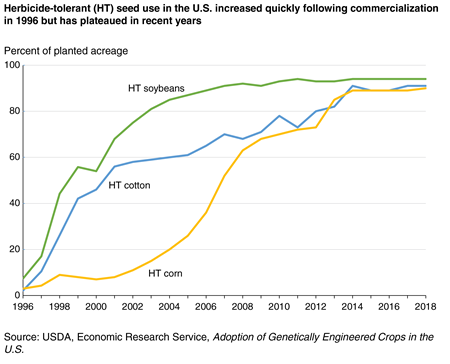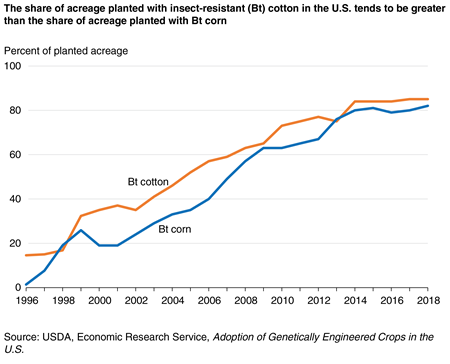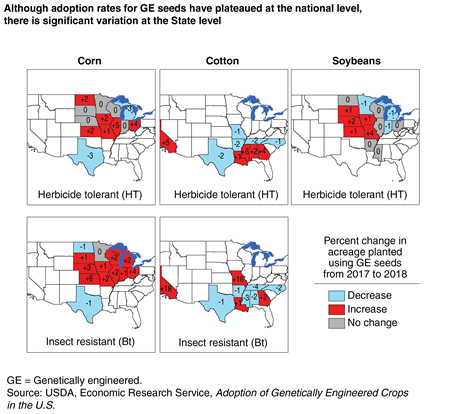Trends in the Adoption of Genetically Engineered Corn, Cotton, and Soybeans

A genetically engineered (GE) plant has had DNA inserted into its genome using laboratory techniques. Some of the first GE crops were created by inserting genes from the soil bacterium Bacillus thuringiensis (Bt) into corn and cotton plants. Bt produces a natural insecticide, so this insertion created crops that were insect resistant. GE herbicide-tolerant (HT) crops, which can survive applications of herbicides that kill most other plants, were also created via the insertion of genes from soil bacteria.
Generally, the use of HT corn, cotton, and soybeans in the U.S. increased quickly subsequent to commercialization in 1996. HT soybean use increased most rapidly, largely because weed resistance to herbicides called ALS inhibitors had developed in the 1980s. By comparison, HT corn use increased relatively slowly, perhaps because corn farmers could use an herbicide called atrazine, which is an effective alternative to glyphosate. Atrazine is safe for corn and can be applied both before and after corn plants start growing. However, it cannot be used on soybeans or cotton.
Demand also increased quickly for Bt crops. Five years after commercialization, approximately 4 out of every 10 cotton acres and 2 out of every 10 corn acres were planted with Bt seeds. Early differences in adoption rates of these two GE crops may be related to the fact that insect infestations tend to be more severe in warmer climates. Cotton growing areas are concentrated in the Southeastern United States and the Southern Plains, which tend to be warmer than growing areas in the Midwest, where most U.S. corn production takes place.
At the national level, adoption rates for GE corn, cotton, and soybeans have plateaued in recent years. However, adoption rates have varied at the State level, particularly in cotton production. From 2017 to 2018, for example, the share of acreage planted with Bt cotton increased by 18 percentage points in California and by 16 points in Missouri. The share of acreage planted with HT cotton increased by 5 percent in California and by 6 percent in Mississippi. These changes reflect increases in the share of acreage planted with seeds that have both HT and Bt traits and decreases in the share of acreage planted with seeds that only have HT traits.
Strikingly, since the turn of the 21st century, there have been large increases in the percentage of acreage planted with seeds that were “stacked” with both HT and Bt traits. In 2000, approximately 1 percent of corn and 20 percent of cotton were produced using stacked seeds. As of 2018, approximately 80 percent of the domestic corn and cotton planted were genetically engineered, stacked seeds.
Among the multiple explanations for increases in the use of stacked seeds is the development of new seed products. For instance, the first rootworm-resistant corn plant (which was sold under the trade name YieldGard) was commercialized in 2003. Other rootworm-resistant corn varieties (which were sold under the trade names Herculex and Agrisure) were commercialized in 2005 and 2006. The commercialization of these products may have encouraged some farmers planting HT seeds that did not have Bt traits to consider a stacked seed. Similarly, the commercialization of new HT traits may induce farmers planting seeds that only have Bt traits to consider a stacked seed variety. The introduction of new seed traits may also help explain why the share of acreage planted with GE seeds has not decreased, despite the development of resistance in some pest populations.
Recently, new HT crop varieties, tolerant of herbicides other than glyphosate, have been commercialized. Seeds with the trade name Enlist are tolerant of 2,4-D choline, while seeds with the trade name Xtend are tolerant of dicamba. Farmers that plant these seeds are able to spray glyphosate-resistant weeds with either 2,4-D or dicamba, even after crop emergence (as dictated by label restrictions). Although some glyphosate-resistant weeds are also tolerant of 2,4-D and dicamba, most can be controlled using these chemicals.
| Crop | Product name | Manufacturer | Resistant to: | Deregulated | Commercialized |
|---|---|---|---|---|---|
| Corn | Enlist | Dow | 2,4-D choline, glyphosate, and select ACCase inhibitors | 2014 | 2018 |
| Cotton | Enlist | Dow | 2,4-D choline, glyphosate, and glufosinate | 2015 | 2016 |
| Xtend | Monsanto | Dicamba, glyphosate, and glufosinate | 2015 | 2016 | |
| Soybeans | Enlist | Dow | 2,4-D choline, glyphosate, and glufosinate | 2014 | 2018* |
| Xtend | Monsanto | Dicamba and glyphosate | 2015 | 2016 | |
| *Enlist soybeans were not approved for import to China prior to the 2018 growing season, so these varieties were grown in a closed-loop production system. HT = Herbicide tolerant. Source: USDA, Economic Research Service analysis using data from various sources. |
|||||
Although products containing 2,4-D and dicamba were commercially available in 2016, these products were not labeled for late-season use on Xtend or Enlist seeds. Herbicide products intended for use in Enlist and Xtend weed control systems were commercialized in 2017. In addition, there is evidence that the dicamba-based products “drift” or “volatilize,” spreading herbicides from weeds to unintended locations under certain environmental conditions. Nonetheless, the commercialization of these crops has provided farmers with alternate methods of controlling glyphosate-resistant weeds.
As the problems posed by glyphosate-resistant weeds intensify, crop varieties with new HT traits are being developed and commercialized. A new HT variety of soybeans (tolerant of herbicides called HPPD inhibitors) will be available to U.S. growers in 2019. Other HPPD tolerant varieties of soybeans are in development.
Adoption of Genetically Engineered Crops in the U.S., by Laura Dodson, USDA, Economic Research Service, October 2023
The Adoption of Genetically Engineered Alfalfa, Canola and Sugarbeets in the United States, by Jorge Fernandez-Cornejo, Seth J. Wechsler, and Daniel Milkove, ERS, November 2016
Genetically Engineered Crops in the United States, by Jorge Fernandez-Cornejo, Seth J. Wechsler, Michael Livingston, and Lorraine Mitchell, USDA, Economic Research Service, February 2014





